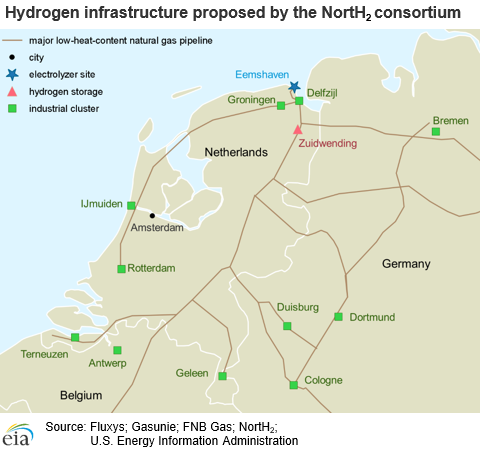News
European consortium to transport H2 on repurposed NG pipelines
Norway's Equinor, the largest producer of natural gas and crude oil in Europe, and Germany's RWE, Europe's second-largest electricity producer, joined the NortH2 green hydrogen consortium on December 7, 2020.
Founded in February 2020 by a trio of Dutch companies—Gasunie, Groningen Seaports, and Shell Nederland—NortH2 aims to convert pipelines throughout the Netherlands and neighboring countries that carry natural gas with a low heat content (L-gas) into pipelines that transport green hydrogen produced from North Sea wind generation. Project development activities could begin in Q2 2021, once a feasibility study is completed.
At present, Gasunie, the Dutch natural gas transmission pipeline operator, maintains two parallel natural gas transmission systems in the Netherlands. One of the pipeline systems transports L-gas that has a high nitrogen component, and the second system transports natural gas with a higher heat content that is primarily composed of methane. Since production of L-gas from the Groningen gas field, the Netherlands' largest natural gas deposit, is being phased out, the NortH2 project will extend the useable life of L-gas transmission pipelines.

Almost all global hydrogen is produced from fossil fuels, which contributes to CO2 emissions. The primary method of hydrogen production, both in the EU and North America, is steam methane reforming (SMR). This process combines methane (natural gas) with steam at high temperatures to yield, through multiple steps, a pure hydrogen stream.
With company-level and EU-wide net-zero CO2 goals in mind, NortH2 aims to produce green hydrogen through electrolysis of water using renewably sourced electricity. Consortium partners propose to build 3–4 GW of offshore wind generating capacity in the North Sea by 2030 and up to 10 GW by 2040 to power electrolyzers onshore at Eemshaven, on the northern coast of the Netherlands.
Since renewable electricity production is variable, depending on load factors, the consortium projects hydrogen production of approximately 1 metric MMtpy, the heat-content equivalent of about 300 MMft3d of natural gas.
The hydrogen would be transported on repurposed L-gas pipelines to either an existing L-gas storage site at Zuidwending, or consumed by industrial consumers in the region. In line with goals outlined in the European Commission's report released in July 2020, "A hydrogen strategy for a climate-neutral Europe," the green hydrogen would, in the initial phases, displace fossil-fuel derived hydrogen. Further down the line, it could contribute to the decarbonization of the petrochemical and iron and steel industries, which are not suitable for electrification.

